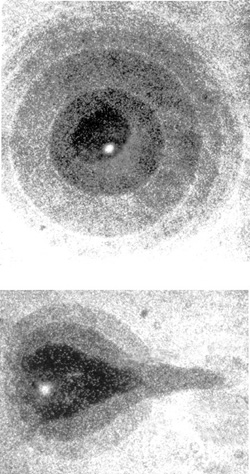Size Matters for Flashing Bubbles

Imagine discovering bubbles in your bathwater that are as hot as the sun’s surface. You might wonder how they got there, and you wouldn’t be alone. For 70 years, physicists have puzzled over sonoluminescence, a process where sound waves create thousands of hot, luminous bubbles in water. To find out what makes the bubbles glow, physicists learned to isolate a single bubble in the center of a water tank. But differences in spectra led some to suspect that single bubble sonoluminescence was a distinct process from the multibubble variety. A paper in the 21 May PRL shows that the two phenomena are the same by explaining the differing spectra. The paper also supports a leading theory for the mechanism of sonoluminescence.
Physicists first saw sonoluminescence in 1934, but it took them over a half-century to figure out what made the bubbles glow. In 1988, researchers used precise acoustic fields to create a single bubble at the center of a water tank. They watched as the sound waves caused the bubble to rapidly expand and then collapse. At the point of collapse, the bubble emitted a pulse of light. Many researchers thought they had finally found the cause of sonoluminescence: The rapid collapse of the bubble heated the gas inside and created a glowing plasma. But when they looked at the light pulse’s spectrum, they noticed it was missing an emission line found in multibubble spectra. The missing line, which corresponded to the common OH molecule, led some to speculate that single-bubble and multibubble sonoluminescence were two unrelated processes.
Now an experiment conducted by Gary Williams and his colleagues at the University of California at Los Angeles suggests that single bubble and multibubble sonoluminescence are nearly identical. Instead of sound waves, the team used a powerful laser pulse to create a bubble inside the water tank. By increasing the laser’s power they could create a millimeter-scale bubble–much larger than those created in the usual single bubble experiments. The bubble expanded and then collapsed like one created by acoustic waves, emitting a pulse of light. The team found that the pulse’s spectrum had the same OH emission line as those from multibubble systems. They concluded that the line is not caused by a unique process in multibubble sonoluminescence, but by the size of the bubbles. Bubbles can grow very large in multibubble systems, and Williams and his colleagues think that the presence of large bubbles creates the characteristic line.
The study also supports the popular theory that a plasma inside the bubble causes sonoluminescence. The team fitted their pulses’ spectra to a blackbody radiation curve, and found they corresponded to plasma temperatures around 8000 K. “8000 K may not sound so high, but remember that the surface of the sun is only 6000 K,” says Williams.
“It’s a nice connecting together of the underlying physical phenomena,” says Ken Suslick, of the University of Illinois in Urbana-Champaign. “And the ability to recognize the OH emission line is pretty cool.” But Williams admits that the team cannot explain what causes the unique spectral line. “We don’t understand exactly where it comes from,” says Williams. He suggests that instabilities in the collapse of large bubbles could create OH. “It’s going to take much more detailed studies,” he says, “to figure out exactly why you get that line.”
–Geoff Brumfiel


